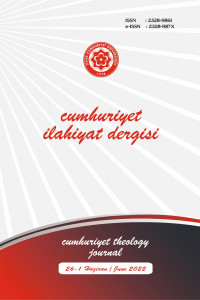Mevlid Nasıl Okunurdu? Yazma Nüshalardaki Makam Kayıtları Üzerine Bir Değerlendirme
How Had The Mawlid Been Chanted? An Evaluation on Maqām Records in Manuscripts
Author(s): Selman BenlioğluSubject(s): Customs / Folklore, Music, Theology and Religion, Turkish Literature, Evaluation research
Published by: Cumhuriyet Üniversitesi İlahyat Fakültesi
Keywords: Turkish Religious Music; Mawlid; Maqām; Wasīlat al-Najāt; Manuscript;
Summary/Abstract: Among the Turkish verse texts, the mawlid named Wasīlat al-Najāt by Süleyman Çelebi has been one of the most widely read works in various geographies for centuries. The text of Mawlid, which has been produced in many manuscripts over time, has diversified, and various versions have emerged. Although there is no detailed information about its beginning and development, it is understood that Süleyman Çelebi’s mawlid had a musical performance form from an early period. In integrating Mawlid with music, various forms of performance developed over time and that it was composed is stated in some narratives, too. In some Mawlid manuscripts, it is found that various maqām names are written next to the couplet or on the margin of the pages. Nineteen manuscripts of the Mawlid registered with maqām information, which have essential clues in terms of the performance of the work, have been identified and analyzed in this study. After a brief introduction of the copies, the formal features of the Mawlid manuscripts with the maqām registered, their characteristics for use in performance, and the frequency of recording the maqām names were evaluated. Except for a few, these manuscripts were prepared in a way that can be followed during the performance in accordance with daily use. Additions and deletions were made over time. Rather than being collectible, they were manuscripts that guide the performer with a functional aspect in the foreground. Of the 19 manuscripts, only Mawlid is found in six, and only Mirajiyya and Mawlid texts are found together in five. In the other two, some lyrics and naʿts were written in addition to the Mawlid. This situation in the content supports the view that the manuscripts are of practical benefit to the performer. The names of maqāms in the manuscripts were located on the right and left of the couplet by writing a maqām name in the margins of each of the Mawlid couplets, and sometimes on the two lines of the couplet. Maqām names are often written as one. There are examples with the phrase “der makam …” at the beginning and examples where it is shown as “tiz Hüseyni”, “tiz ender tiz Hüseyni”, “Hüseyni pes baʻde tiz” and “Dügāh teslim”. It seems that the owners of the manuscripts recorded their performance preferences and habits in a way that they can understand, sometimes basically and sometimes as detailed as possible. Among the manuscripts with a known copy date, the earliest one is from 1699, and the latest from 1888. The Mawlid text in the manuscripts ranges from 81 to 526 couplets. The average of the total number of couplets is 185.6. The frequency of recording maqāms varies also between copies. While the name of the maqām was written in 15.9% of the couplets in A 7940, which had the lowest record, the maqāms were recorded in all of the couplets in TY 549 and MS 323 copies. As a result, the ratio of couplets with maqām record in 19 manuscripts is 68.1%. A wide range of maqāms has been used in the manuscripts. Although not all of them were mentioned in each manuscript, when considered collectively, it is seen that 40 different maqāms were used. The three maqāms most frequently recorded in manuscripts are Hüseyni (26.8%), Pençgāh (13.7%) and Dügāh (13.3%). On the other hand, although the frequency of recording in manuscripts was low, less-known and rarely used maqāms such as Geveşt, Nişāburek, Müberka, Necd-i Hüseyni and Vech-i Hüseyni were also encountered. Among the manuscripts, 25 different maqāms were used in H 1286, which had the highest number of maqāms, and 12 different maqāms were used each in A 7940 and MIF 67, which had the least number of maqāms. There were 5 maqāms used in common in all 19 manuscripts: Acem, Dügāh, Hüseyni, Nevā and Pençgāh. They were also the most registered maqāms in total. Although there are some similarities in terms of text and maqāms in the Mawlid copies examined in the study, there is no complete overlap, an agreed structure, in short, a standard. The literature on the maqām recorded manuscripts of Mawlid tends to see these copies as evidence of a composed Mawlid. However, there is no mention in any of the manuscripts about the composer of the piece, whether the piece was composed, or whether the recorded maqāms reflect a composition. Moreover, there is a wide variety in the manuscripts that are the subject of the study, both in terms of the Mawlid text and the maqāms registered in the margins. With a modern attitude, it seems that researchers who have dealt with the subject in the last century have been in search of an order and consistency in the tradition of performing Mawlid. They have envisioned the musical dimension of Mawlid, which has managed to stay in circulation over the centuries, in a systematic structure. It is clear that this approach should be discussed with different dimensions in the light of the new results reached in the present study.
Journal: Cumhuriyet İlahiyat Dergisi
- Issue Year: 26/2022
- Issue No: 1
- Page Range: 191-211
- Page Count: 22
- Language: Turkish

